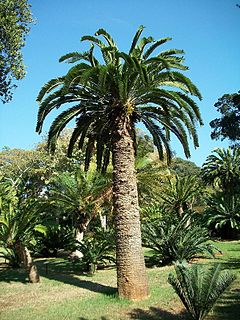ONgoye Forest
| oNgoye Forest | |
|---|---|

An original stem of Wood's cycad at the Durban Botanic Gardens, once endemic to oNgoye Forest
|
oNgoye Forest, also known as Ngoye or Ngoya Forest, is an ancient coastal scarp forest, protected by the oNgoye Forest Reserve in South Africa's KwaZulu-Natal province. The forest of almost 4,000 ha covers an extensive granite ridge that rises from 200 to 460 metres above sea level. It is found some 10 km inland, or 16 km by road, from the coastal town of Mtunzini, and adjoins smaller forest reserves on its periphery, namely Impeshulu in the west, Ezigwayini in the north, and Dengweni in the south.
The Zulu king Mpande is the first known person to have afforded protection to oNgoye Forest in the 1800s. Commercial logging occurred in the forest between 1909 and 1924.
The area became an official conservation area in 1992. Cattle grazing, crop cultivation and limited utilization of trees however occur in the protected area, and the edge of the forest is subjected to periodic burning which may reduce the forest area.
This relict patch of transitional Afromontane-coastal forest is home to rare and endemic species.
It was home to the giant Wood's cycad which is extinct in the wild since the early 1900s, but the oNgoye dwarf cycad, ground cycad and Natal grass cycad still occur.
It is home to the endemic race ornatus of the red bush squirrel, the endemic race woodwardi of Woodward's barbet, two undescribed dwarf chameleons similar to the Qudeni dwarf chamaeleon, the rare forest green butterfly and the oNgoye centipede.
This forest is an important breeding area for the eastern bronze-naped pigeon and home to the endangered spotted ground thrush. At least 165 species of birds have been identified in the area.
...
Wikipedia
